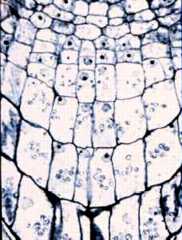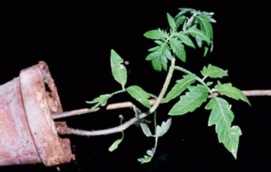|
Scientists hope that an unusual experiment
slated for launch on the space shuttle this summer will reveal how
plants know up from down.
by Patrick Barry and Dr Tony
Phillips
When gardeners poke a seed into the ground,
they never worry in which direction it lays. Give it enough water
and food and care, and sure enough, its root will grow downward and
its stem will sprout upward - every time! Lay the seed upside-down,
and the root and stem would still find their proper positions.
Everyone knows that plants grow toward light, but
there must be more to it than that. Trees in northern forests, for
example, grow straight up even though the Sun is never directly
overhead, and the first stem emerging from a buried seed grows upward
through dark soil.
It's clear that gravity must play some role, too.
Indeed, scientists know that the direction of gravity's pull is
behind many plant behaviours, such as corn crops righting themselves
after being flattened by a storm. What's unclear is exactly how
plants "feel" gravity and respond to it. What part of a plant senses
the direction of gravity's pull? And how is that pull translated
into a chemical response that alters the plant's growth?
No one knows the answers.
But scientists do know enough to suggest two possibilities. First,
when the fluid contents of plant cells (called the "protoplasm")
are pulled downward by gravity, the pressure exerted on the cell
walls might serve as a signal that helps plants distinguish up from
down. Second, plant cells contain starch grains which, like protoplasm,
drift down when gravity is present. Scientists suspect this might
act as a cue to plants, too.

Image courtesy NASA.
Seen under
a microscope, the starch grains in these plants cells are
visible as small dots.
|
But which is it? A novel experiment
slated to fly aboard the space shuttle might reveal the answer.
Karl Hasenstein, principal investigator
for the BioTube/Magnetic Field Apparatus experiment, explains: The
shuttle will carry a payload of flax seeds to orbit. Once there,
a computer-controlled dose of water will start them growing. Unlike
flax sprouts growing on Earth, these won't feel the usual pull of
gravity. The protoplasm and the starch grains within their cells
will float rather than sink.
Plants have been grown in space before. But this experiment will
be the first to subject plants to an "artificial gravity" created
by magnets.
The experiment will have a high-gradient magnetic field in the plant
growth chamber. Within the cells of the plants, the protoplasm will
be essentially unaffected by the magnet, but the starch grains will
feel the magnetic force. They will sink to the bottom of the cell
as if drawn there by gravity.
Starch grains are not magnetic in the
usual sense - if you held one against your refrigerator it wouldn't
stick. But the grains are "diamagnetic," which means they develop
a weak magnetic field when other magnets are nearby. The diamagnet's
field will naturally oppose that of the nearby magnet - hence the
prefix "dia" - so the starch grains will be repelled. Although
the effect is weak, this diamagnetic response allows researchers
to use magnets to move the starch grains.
"By changing only the internal displacement
of the starch grains, we can put one of these two arguments to rest,"
explains Hasenstein, a professor at the University of Louisiana
at Lafayette. "If the starch grains are the gravity-sensing trigger,
we should see the flax-seed roots curve along the magnetic gradient.
And if the pressure on the cell walls triggers the curvature, we
should see no response."

Image courtesy University
of Wisconsin-Madison.
This plant
originally sprouted with the pot upright and was later turned
on its side. The new stem growth curved to re-align with
gravity.
|
Infrared cameras will automatically
photograph the germinating roots. Regular cameras can't be used
because the chamber will be kept completely dark. The darkness allows
scientists to know that the seeds are responding to the magnetic
fields, not just growing toward a light source.
Don't bother trying this experiment
at home with ordinary refrigerator magnets. Only special "high-gradient"
magnetic fields will do. Hasenstein's experiment uses magnets about
50 times more powerful than a typical refrigerator magnet. The magnets
have ferromagnetic wedges attached to them, which focus a strong
magnetic field into a small area. Around that area, the strength
of the field tapers off quickly, creating the "gradient" of field
strength that moves the starch grains.
High-gradient magnetic fields will be used in two chambers of the
experiment, while a third chamber will use a homogeneous magnetic
field as a "control."
The lessons learned won't only apply
to flax seeds (which were chosen for their small size and their
quick, reliable germination). All normal plants have these starch
grains, so the results of this experiment will add to our basic
understanding of plants in general.
Starch grains or protoplasm? No matter which proves correct, researchers
will have lingering questions. For example: "how does the mechanical
trigger (e.g., starch grains drifting downward) produce a
biochemical response?" BioTube/MFA won't provide all the answers
right away, but it is an important first step - one that will teach
us something fundamental about the leafy-green life all around us.
|
